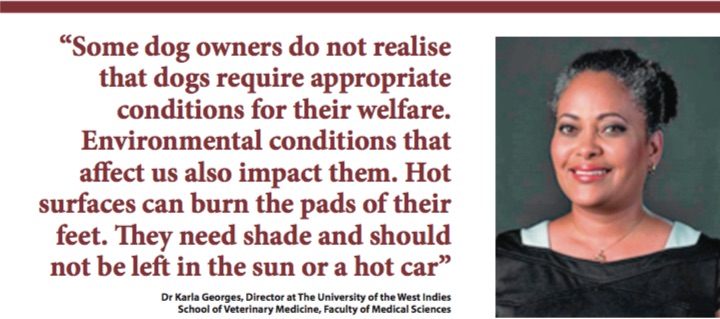We all know the age-old adage about dog being man’s best friend. But they can also be man’s best co-worker. For centuries, dogs have helped shepherds guard their fields and, in the last 100 years, they have taken on the roles of service animals, assisted in search and rescue, and been part of the police forces. As Dr Karla Georges, Director at The University of the West Indies School of Veterinary Medicine (UWI-SVM), points out, “Dogs are very intelligent, and aim to please. They can be trained to find almost anything.”

UWI-SVM held training workshops on two consecutive Saturdays, February 1 and February 8, for officers of the Trinidad and Tobago Police Service and the Trinidad and Tobago Prison Service. They centred on improving knowledge of canine health to help the officers learn more about caring for the health of their furry companions.
While several of the officers had prior exposure to veterinary practice before at the School’s small animal clinic, this is the first time they have had formal training. But after two sessions, the officers unanimously requested that the Veterinary School conduct these sessions at a minimum of twice per year, and include more contact hours—especially in terms of practical sessions.
Many of the topics – general canine health and recognising normal from abnormal, dealt with issues that even pet owners at home may come across, like heatstroke or tick fever. Some, like wounds and bandaging, were more focused on issues that police dogs may be at higher risk for because of the nature of their jobs.
“Police dogs are trained to find narcotics, ammunition, missing persons, and immobilise targets,” says Dr Georges. “They also protect borders from customs to find illegal food and smuggled animals. They warn their handlers of danger and survey hard- to-access terrain to find targets.” With all of these jobs to do, there are different breeds of dogs that are used in different capacities. Dr Georges shares that our police force uses breeds of Labrador Retrievers, German Shepherds and Belgian Malinois, based on their capacity for intelligence, skill, obedience and confidence. Our prison officers work with Shepherds, Malinois, and some crosses. “It all depends on what is needed. Other dog breeds with those skills are used, like Beagles and Cocker Spaniels. More aggressive-type dogs may be used as canine officers to immobilise a suspect.”
“Canine officers are an integral part of law enforcement activities – it is important that their handlers are equipped to recognise deviations in health and behaviour,” says Dr Georges. With this in mind, five contact hours consisting of a mix of didactic and practical sessions was delivered to 27 officers – the sessions were lively and dynamic, affording officers the opportunity to describe their experiences and gain the tools necessary for recognising common conditions of working dogs.
Dr Georges coordinated and conducted sessions along with her team Candice Sant, Gillian Williams, Sabrina Thomas, Tennille Auguste, Ansarah Hosein, Jayde Felician, Lisa Benjamin and Teola Noel. “We would like to thank Sgt David Prince and Anil Ramnanan [former UWI-SVM graduate and veterinarian] from the Prisons and Police Service and the canine officers who patiently allowed the demonstration sessions.”
The lessons learned during these two sessions can be crucial for civilian pet owners as well. “Some dog owners do not realise that dogs require appropriate conditions for their welfare. Environmental conditions that affect us also impact them. Hot surfaces can burn the pads of their feet. They need shade and should not be left in the sun or a hot car,” recommends Dr Georges. “They should not be chained or kennelled extensively.”

Like their distant cousins, wolves, dogs are social creatures. Part of keeping them healthy, is keeping them mentally and physically engaged. As Dr Georges notes, this helps to prevent stress behaviour, because as people may not know, “They can and do experience stress-related disorders. They need socialisation, exercise, and good nutrition.” She also pointed out that it is important to be mindful of regular household items around pets. “Certain medications routinely used for humans are toxic for dogs.”
Whether they are at work alongside our police force or at home in the backyard, there are lessons to be learned from these sessions on how to take care of our furry friends. In fact, much of their care is similar to care for ourselves — regular mental and physical activity, proper nutrition, and being social for a healthy, happy body and mind.